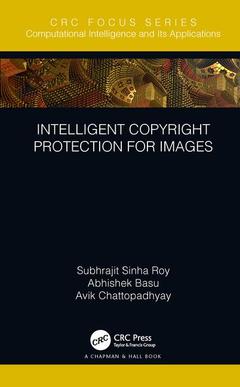Description
Intelligent Copyright Protection for Images
Chapman & Hall/CRC Computational Intelligence and Its Applications Series
Authors: Sinha Roy Subhrajit, Basu Abhishek, Chattopadhyay Avik
Language: English
Subjects for Intelligent Copyright Protection for Images:
Keywords
Image Watermarking; intelligent image clustering; SSIM Index; copyright protection system; Signal Processing Attacks; invisible image watermarking; Watermarking Scheme; Data Hiding Scheme; Information Hiding Techniques; Fragile Watermark; Watermark Bits; SSIM; Watermark Embedding; Digital Watermarking; Saliency Map Model; Altera FPGA; Data Hiding Capacity; Saliency Map; Digital Image Watermarking; DCT Domain; Watermarking Technique; Saliency Detection; Execution Time; Watermarking Algorithm; Binary Watermark; Host Image; FPGA Implementation; DCT Coefficient
Approximative price 66.20 €
In Print (Delivery period: 14 days).
Add to cart· 13.8x21.6 cm · Hardback
Description
/li>Contents
/li>Biography
/li>
Contents
Preface, xi
Acknowledgments, xv
About the Authors, xvii
Chapter 1 ▪ Introduction 1
1.1 INFORMATION HIDING AND COPYRIGHT
PROTECTION 1
1.1.1 Overview 1
1.1.2 Hiding Techniques 2
1.1.2.1 The Ancient Age 3
1.1.2.2 The Modern Age 6
1.2 DIGITAL WATERMARKING AS A COPYRIGHT
PROTECTION TOOL 11
1.2.1 Overview 11
1.2.2 Basic Operations 13
1.2.3 Classification 16
1.2.4 Properties for a Good Digital
Watermarking Scheme 19
1.2.5 Application 21
1.2.6 Attacks 24
Chapter 2 ▪ Perspectives on Digital Image
Watermarking 27
2.1 INTRODUCTION TO DIGITAL IMAGE 27
2.2 VARIOUS TECHNIQUES OF DIGITAL IMAGE
WATERMARKING 32
2.2.1 Spatial Domain Practices 32
2.2.2 Frequency Domain Practices 35
2.3 SOME EXISTING FRAMEWORKS FOR
DIGITAL IMAGE WATERMARKING 44
Chapter 3 ▪ Intelligent Systems Used in Copyright
Protection 59
3.1 VISUAL SALIENCY AND ITS PURPOSE IN
DIGITAL WATERMARKING 61
3.1.1 Saliency and Salient Object 61
3.1.2 The Purpose of Saliency in Digital
Watermarking 61
3.1.3 Saliency Detection and a Saliency Map 62
3.1.4 Various Saliency Map Algorithms for
Images 64
3.2 INTELLIGENT IMAGE CLUSTERING: THE
K-MEANS ALGORITHM 67
3.2.1 Data Clustering 67
3.2.2 Need for Data Clustering in Digital Image
Watermarking 70
3.2.3 K-means Algorithm for Data Clustering 71
Chapter 4 ▪ Copyright Protection Framework 75
4.1 WATERMARK EMBEDDING SYSTEM 75
Step 1: Evaluating the Saliency Map from the
Cover Image 77
Step 2: Constructing the Hiding Capacity Map
from the Saliency Map 80
Step 3: Constituting the Watermarked Image
through Adaptive LSB Replacement 83
4.2 WATERMARK EXTRACTING SYSTEM 86
Chapter 5 ▪ Hardware Implementation 91
5.1 OVERVIEW OF HARDWARE REALIZATION
FOR DIGITAL WATERMARKING 92
5.2 HARDWARE ARCHITECTURE FOR THE
PROPOSED IMAGE WATERMARKING SCHEME 96
5.2.1 Watermark Embedding System 96
5.2.2 Watermark Extracting System 100
Chapter 6 ▪ System Evaluation 105
6.1 EMBEDDING SYSTEM OUTCOMES 105
6.2 ESTIMATION OF DATA HIDING CAPACITY 108
6.3 ANALYSIS OF IMPERCEPTIBILITY OR DATA
TRANSPARENCY 109
6.3.1 Description of Image Quality Metrics,
Involved in Imperceptibility Analysis 109
6.3.2 Evaluation of Imperceptibility for the
Proposed Watermarking Scheme 115
6.4 OUTPUTS OF THE WATERMARK
EXTRACTING SYSTEM AND ITS EFFICACY IN
TERMS OF ROBUSTNESS 122
6.5 COMPARATIVE STUDY ON THE
PROFICIENCY OF THE PROPOSED
WATERMARKING SYSTEM 125
6.6 AN EVALUATION OF HARDWARE SYSTEMS
FOR THE PROPOSED WATERMARKING LOGIC 126
Chapter 7 ▪ Conclusion 131
REFERENCES 135
INDEX 151
Mr. Subhrajit Sinha Roy received his B. Tech. in Electronics and Communication Engineering from West Bengal University of Technology in 2012 and M. Tech. in Telecommunication from RCC Institute of Information Technology (under West Bengal University of Technology), Kolkata, India, in 2015. At present he is an Assistant Professor in the department of Electronics and Communication Engineering at Global Institute of Management and Technology, Krishnagar, West Bengal, India. He has also been enrolled in the Department of Radio Physics and Electronics under Calcutta University for Ph.D in Engineering and Technology. Till date he has six research publications in international journals, conference proceedings and edited volumes to his credit. His field of interest spans digital image processing, information hiding, FPGA based system design, low power VLSI design and quantum computing.
Dr. Abhishek Basu received his B. Tech. in Electronics and Telecommunication Engineering from West Bengal University of Technology in the year 2005, M. Tech. in VLSI Design from Institute of Radio Physics and Electronics, University of Calcutta, India in 2008 and Ph. D (Engg) from Jadavpur University, India in 2015. He is currently the Assistant Professor and Head of the Department of Electronics and Communication Engineering department of RCC Institute of Information Technology, Kolkata, India. He served as under graduate Program coordinator in the above mentioned Dept. during 30th march 2016 to 1st January, 2017. He is co-editor of a book and has more than 40 research publications in international journals, conference proceedings and edited volumes to his credit. He is the hospitality chair of International Conference on Intelligent Control, Power and Instrumentation (ICICPI 2016), during October 21th -23th, 2016. He is the member of the organizing and technical program committees of several national and international conferences. His research int



